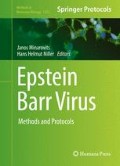Abstract
Recent developments in mouse models that harbor part of a human immune system have proved extremely valuable to study the in vivo immune response to human specific pathogens such as Epstein-Barr virus. Over the last decades, advances in immunodeficient mouse strains that can be used as recipients for human immune cells have greatly enhanced the use of these models. Here, we describe the generation of mice with reconstituted human immune system (HIS mice) using immunocompromised mice transplanted with human CD34+ hematopoietic stem cells. We will also describe how such mice, in which human immune cells are generated de novo, can be used to study EBV infection.
Access this chapter
Tax calculation will be finalised at checkout
Purchases are for personal use only
References
Traggiai E, Chicha L, Mazzucchelli L et al (2004) Development of a human adaptive immune system in cord blood cell-transplanted mice. Science 3(04):104–107
Heuts F, Rottenberg ME, Salamon D et al (2014) T cells modulate Epstein-Barr virus latency phenotypes during infection of humanized mice. J Virol 88:3235–3245
Rickinson AB, Kieff E (2001) Epstein–Barr virus. In: Knipe DM, Howley PM (eds) Fields virology, vol 2, 4th edn. Lippincott Williams and Wilkins, Philadelphia, pp 2575–2628
Moss DJ, Rickinson AB, Pope JH (1978) Long-term T-cell-mediated immunity to Epstein-Barr virus in man. I Complete regression of virus-induced transformation in culture of seropositive donor leukocytes. Int J Cancer 22:662–668
Ono A, Hattori S, Kariya R, Iwanaga S (2011) Comparative study of human hematopoietic cell engraftment into BALB/c and C57BL/6 strain of rag-2/jak3 double-deficient mice. BioMed Research 2011:539748. doi:10.1155/2011/539748
Lepus CM, Gibson TF, Gerber SA et al (2009) Comparison of human fetal liver, umbilical cord blood, and adult blood hematopoietic stem cell engraftment in NOD-scid/gammac−/−, Balb/c-Rag1−/−gammac−/−, and C.B-17-scid/bg immunodeficient mice. Hum Immunol 70:790–802
Strowig T, Chicha L, Mazzucchelli L et al (2009) Priming of protective T cell responses against virus-induced tumors in mice with human immune system components. J Exp Med 206:1423–1434
Bell AI, Groves K, Kelly GL et al (2006) Analysis of Epstein-Barr virus latent gene expression in endemic Burkitt’s lymphoma and nasopharyngeal carcinoma tumour cells by using quantitative real-time PCR assays. J Gen Virol 87:2885–2890
Hamalainen HK, Tubman JC, Vikman S et al (2001) Identification and validation of endogenous reference genes for expression profiling of T helper cell differentiation by quantitative real-time RT-PCR. Anal Biochem 299:63–70
Author information
Authors and Affiliations
Corresponding author
Editor information
Editors and Affiliations
Rights and permissions
Copyright information
© 2017 Springer Science+Business Media New York
About this protocol
Cite this protocol
Heuts, F., Nagy, N. (2017). Mice with Reconstituted Human Immune System Components as a Tool to Study Immune Cell Interactions in EBV Infection. In: Minarovits, J., Niller, H. (eds) Epstein Barr Virus. Methods in Molecular Biology, vol 1532. Humana Press, New York, NY. https://doi.org/10.1007/978-1-4939-6655-4_17
Download citation
DOI: https://doi.org/10.1007/978-1-4939-6655-4_17
Published:
Publisher Name: Humana Press, New York, NY
Print ISBN: 978-1-4939-6653-0
Online ISBN: 978-1-4939-6655-4
eBook Packages: Springer Protocols

